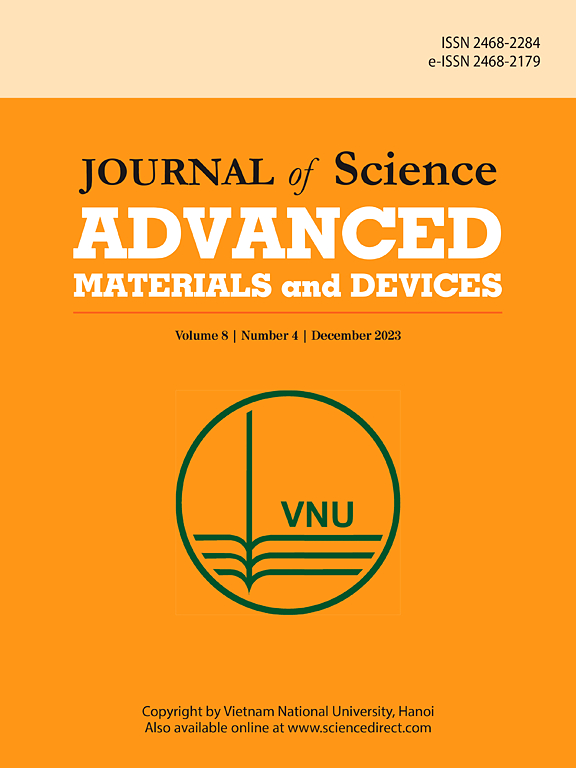Design, characterization, and electromagnetic performance of a flexible wideband RF antenna using composite materials
IF 6.7
3区 材料科学
Q1 MATERIALS SCIENCE, MULTIDISCIPLINARY
Journal of Science: Advanced Materials and Devices
Pub Date : 2024-12-31
DOI:10.1016/j.jsamd.2024.100847
引用次数: 0
Abstract
Traditional microwave and microelectronic technologies typically use metal components for high efficiency, but their rigidity and susceptibility to corrosion limit their suitability for wearable applications. To meet the demand for flexible, high-performance materials in wearable communication systems, this study investigates the use of Poly (vinylidene fluoride-co-hexafluoropropylene) (PVDF-HFP) combined with calcium- and zirconium-doped barium titanate (BCZT) as a novel substrate for microwave applications. A flexible wideband antenna was developed using a PVDF-HFP/BCZT composite, with BCZT particles enhancing the composite's thermal stability, crystallinity, and dielectric performance. Conductive fabric was employed for the antenna's radiating elements, supporting both flexibility and user comfort. The antenna was fabricated via laser cutting and tested in free space and on a human body model, achieving a resonant frequency of 5.94 GHz, a return loss of −48.32 dB, and a wide bandwidth of 5.10–6.40 GHz, with VSWR below 2 and a radiation efficiency of 60%. Specific absorption rate (SAR) testing with a multilayer human tissue model yielded values of 1.22 W/kg (1g) and 0.366 W/kg (10g), in compliance with international safety standards. Experimental results closely aligned with simulations, demonstrating the potential of PVDF-HFP/BCZT-based antennas as eco-friendly, high-performance solutions for wearable technologies, achieving an effective balance between flexibility and efficiency.
使用复合材料的柔性宽带射频天线的设计、表征和电磁性能
传统的微波和微电子技术通常使用金属元件来提高效率,但它们的刚性和对腐蚀的敏感性限制了它们在可穿戴应用中的适用性。为了满足可穿戴通信系统对柔性、高性能材料的需求,本研究研究了将聚偏氟乙烯-共六氟丙烯(PVDF-HFP)与钙和锆掺杂钛酸钡(BCZT)结合作为微波应用的新型衬底。利用PVDF-HFP/BCZT复合材料开发了一种柔性宽带天线,BCZT颗粒增强了复合材料的热稳定性、结晶度和介电性能。天线的辐射元件采用导电织物,既灵活又舒适。该天线采用激光切割制作,并在自由空间和人体模型上进行了测试,谐振频率为5.94 GHz,回波损耗为- 48.32 dB,带宽为5.10-6.40 GHz,驻波比小于2,辐射效率为60%。多层人体组织模型的比吸收率(SAR)测试结果分别为1.22 W/kg (1g)和0.366 W/kg (10g),符合国际安全标准。实验结果与仿真结果密切一致,证明了PVDF-HFP/ bcz天线作为可穿戴技术的环保、高性能解决方案的潜力,实现了灵活性和效率之间的有效平衡。
本文章由计算机程序翻译,如有差异,请以英文原文为准。
求助全文
约1分钟内获得全文
求助全文
来源期刊

Journal of Science: Advanced Materials and Devices
Materials Science-Electronic, Optical and Magnetic Materials
CiteScore
11.90
自引率
2.50%
发文量
88
审稿时长
47 days
期刊介绍:
In 1985, the Journal of Science was founded as a platform for publishing national and international research papers across various disciplines, including natural sciences, technology, social sciences, and humanities. Over the years, the journal has experienced remarkable growth in terms of quality, size, and scope. Today, it encompasses a diverse range of publications dedicated to academic research.
Considering the rapid expansion of materials science, we are pleased to introduce the Journal of Science: Advanced Materials and Devices. This new addition to our journal series offers researchers an exciting opportunity to publish their work on all aspects of materials science and technology within the esteemed Journal of Science.
With this development, we aim to revolutionize the way research in materials science is expressed and organized, further strengthening our commitment to promoting outstanding research across various scientific and technological fields.
 求助内容:
求助内容: 应助结果提醒方式:
应助结果提醒方式:


